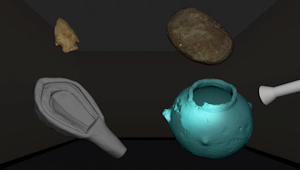
Proponents of the extended (Clark 2003), enacted (Varela et al. 1991), embodied (Ratey 2002; Lakoff and Johnson 1980; 1999; Cole 1985), distributed (Norman 1988; Hutchins 2005), mediated, and situated (Suchman 1987; Lave 1988; Wilson and Myers 2000) mind accept the idea that when people engage with material things, they think with them. Some archaeologists (MacGregor 1999; Ingold 2007; Olsen 2010) also stress the importance of material qualities for the perception of artefacts. As Tim Ingold (2007, 11) puts it: 'materials are the active constituents of a world-in-formation' and can tell us about a place and a time (hic et nunc), about the people who created or used the artefacts, and also about changes over time. For Ingold (2007, 14), the properties of materials, which also have to be considered constituents of an environment, 'are neither objectively determined nor subjectively imagined, but practically experienced'. In other words, it is important to understand how people experience material objects when they physically manipulate (i.e. touch) them and how this experience changes when the objects are digitally reproduced and the experience occurs within a virtual domain. Colin Wave highlights how visualisation is an important instrument for analysing and understanding cultural heritage by enhancing our perception of objects' affordances/agency (Wave 2004, 3). 2D visual representations are commonly used in archaeological and cultural heritage practice to represent, preserve and disseminate visual representation of ancient material culture, because they are simple, fast and cost-effective. However, they are not always ideal forms of reproduction in order to grasp physical characteristics that are sometimes crucial in order to understand the use(s) of these objects in the past. In a recent study, Galeazzi et al. (2015) compared 2D and 3D digital images to see how people's perception of artefacts changes based on the medium used to archive their visual representations. A set of experiments conducted with university students showed how 3D digital replicas of artefacts are a more effective means of digitally preserving tangible cultural heritage because 3D multi-visualisation augments perception of the specific physical qualities that are crucial to grasp the functionality of these objects in the past. This allows an experience with the artefacts that is closer to a real-life one, since the possibility of interacting with the multiple levels of information encapsulated in the 3D representation (texture, mesh, vertexes, and wireframe) simulates, to some extent, real-life experiences better than 2D visual representations (Galeazzi et al. 2015, 481). In another study, titled Experiencing Artefacts through Different Media, Di Giuseppantonio Di Franco et al. (2016) also analysed how the perception of inner qualities of artefacts is achieved in immersive systems. The results from this study reinforce the idea that presentation modalities affect how different characteristics of objects are perceived. In this study we compared perception through three different media:

In the Powerwall condition, participants had the option to manipulate the objects interactively and select specific actions through a virtual floating menu (Figure 6a-b). As shown in Figure 7, the user controlled a virtual pointer in the scene (red cone) directly mapped to the position in space of the remote controller. The virtual pointer appears to the user to be floating in front of the controller being held. Users manipulate objects by selecting them with the virtual pointer and then using manipulations that are very similar to everyday real life. Through a virtual menu that could be opened and removed at will (Figure 6c), two actions were possible (Figure 7): removing original colours (i.e. texture) to appreciate the 3D model geometry mesh, and changing light conditions (environmental or torch-light simulation, and light-source colours). No virtual scale accompanied the objects displayed during the experiment. After the users had interacted with the 3D digital replicas they completed a questionnaire to explain their experience with each object. The questionnaires were analysed in order to determine which type of interaction would be most suitable for research needs and for the presentation of archaeological material to the general public. Each participant was allowed to interact with just one of the three use-cases alternatives that were implemented (i.e. display case object, Powerwall, or 3D prints).


We chose four objects for the experiment: a ceramic vessel (i.e. pot), a grinding stone (i.e. mono), a projectile point, and a wooden Buddhist niche for figurines. Without going into too much detail, to give an example regarding texture qualities, our findings suggest that in the case of small, bright, and light-coloured objects, such as the projectile point, visual cues are not enough to perceive texture qualities accurately. While participants in the Look condition could grasp the sense of texture of the objects based only on visual cues, participants in the Powerwall could rely on multi-visualisation tools, such as different light settings and the ability to zoom in and remove original colours from the 3D models, to grasp textural information.
Internet Archaeology is an open access journal based in the Department of Archaeology, University of York. Except where otherwise noted, content from this work may be used under the terms of the Creative Commons Attribution 3.0 (CC BY) Unported licence, which permits unrestricted use, distribution, and reproduction in any medium, provided that attribution to the author(s), the title of the work, the Internet Archaeology journal and the relevant URL/DOI are given.
Terms and Conditions | Legal Statements | Privacy Policy | Cookies Policy | Citing Internet Archaeology
Internet Archaeology content is preserved for the long term with the Archaeology Data Service. Help sustain and support open access publication by donating to our Open Access Archaeology Fund.